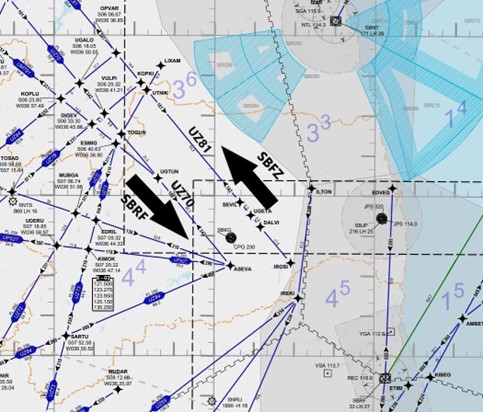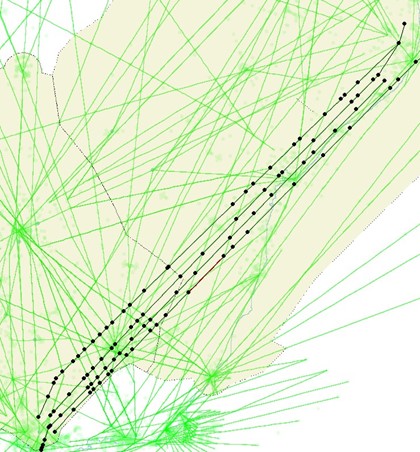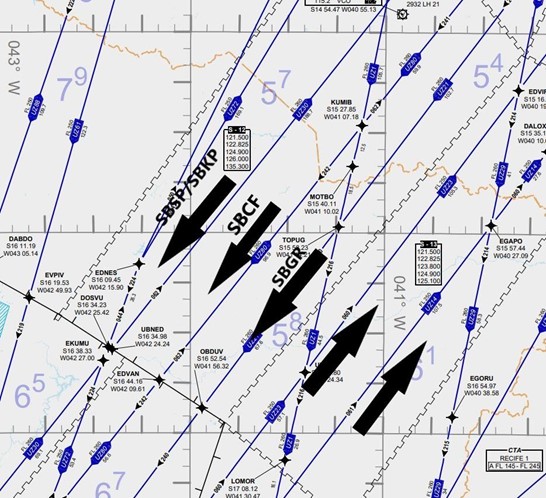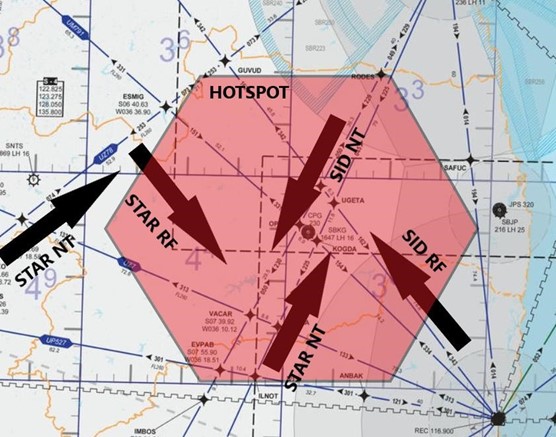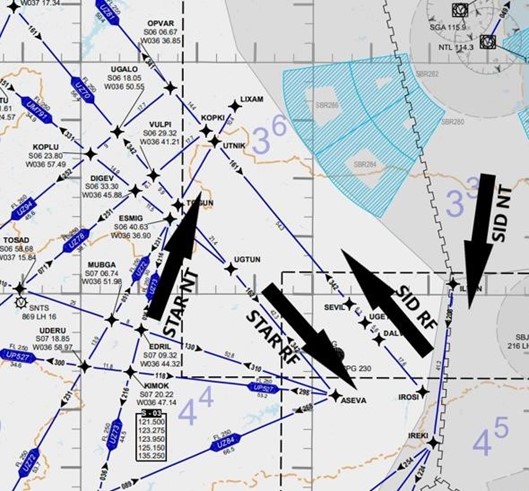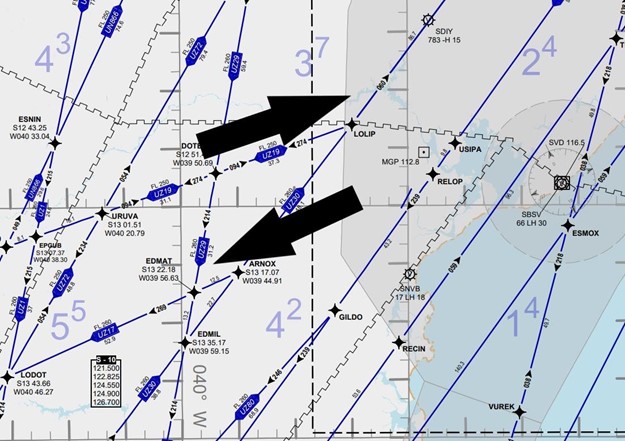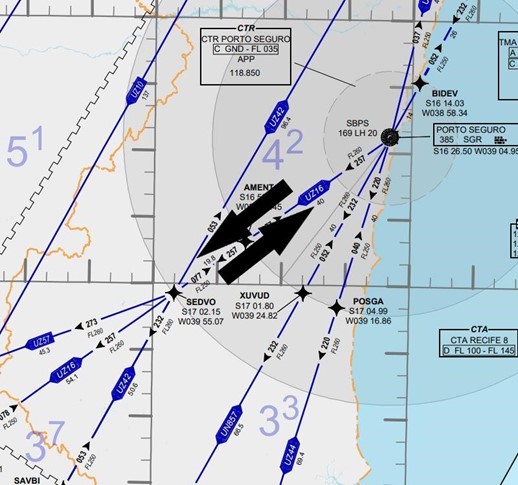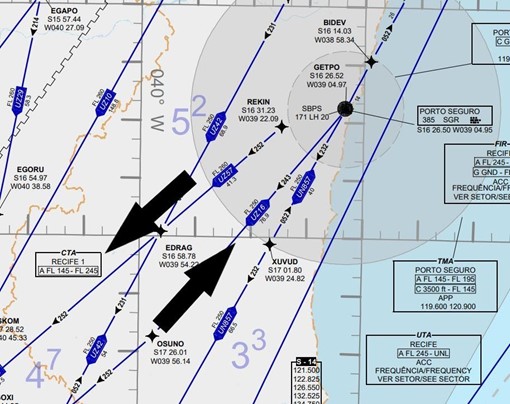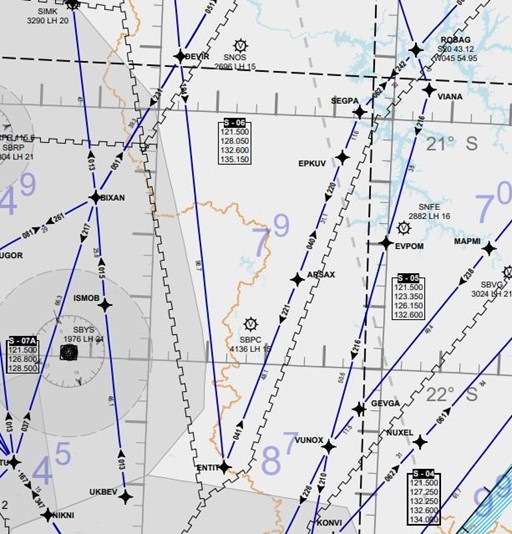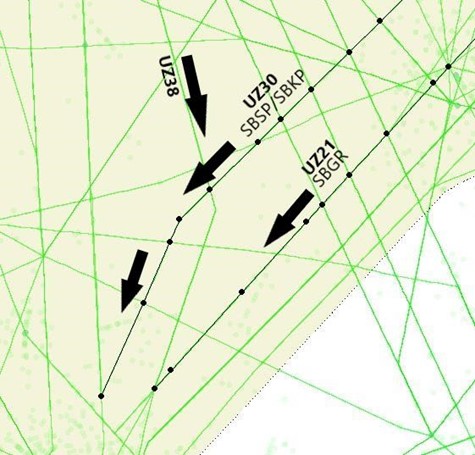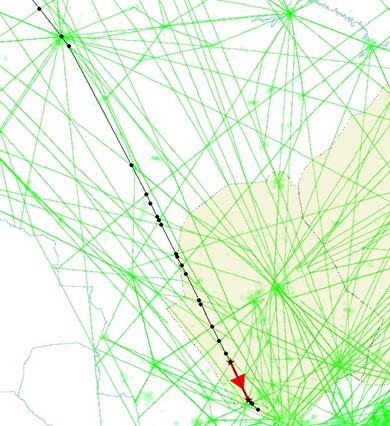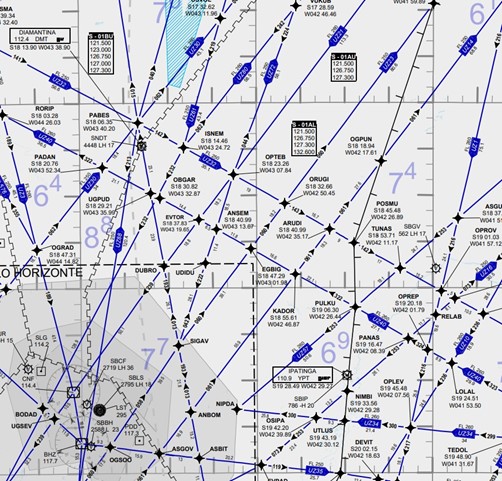This Aeronautical Information Circular (AIC) aims to disclose the changes in airspace in FIR RE and FIR BS, arising from the Eficiência Project, implemented in the amendment of 05 OCT 23.
This (AIC) applies to users of the Brazilian Airspace Control System (SISCEAB) and to Air Traffic Services (ATS) professionals in Brazil.
In this AIC, the abbreviations below have the following meanings:
AIC Aeronautical Information Circular
ATC Air Traffic Control
CCO Continuous Climb Operations
CDM Collaborative Decision Making
CDO Continuous Descent Operations
DECEA Department of Airspace Control
RA Restricted Area
FIR Flight Information Region
ICA Institute of Aeronautical Cartography
IFR Instrument Flight Rules
NM Nautical Mile
ICAO International Civil Aviation Organization
PBN Performance-based navigation
RNAV Area Navigation
SID Standard Instrument Departure
SISCEAB Brazilian Airspace Control System
STAR Standard Terminal Arrival
TMA Terminal Control Area
AIC Aeronautical Information Circular
ATC Air Traffic Control
CCO Continuous Climb Operations
CDM Collaborative Decision Making
CDO Continuous Descent Operations
DECEA Department of Airspace Control
RA Restricted Area
FIR Flight Information Region
ICA Institute of Aeronautical Cartography
IFR Instrument Flight Rules
NM Nautical Mile
ICAO International Civil Aviation Organization
PBN Performance-based navigation
RNAV Area Navigation
SID Standard Instrument Departure
SISCEAB Brazilian Airspace Control System
STAR Standard Terminal Arrival
TMA Terminal Control Area
The terms and expressions listed below, used in this Instruction, have the following meanings:
DEDICATED AIRWAY
Airway used to optimize the air traffic flow, especially in areas of high traffic density favoring the operation in a certain direction.
ATC CAPACITY
Maximum number of aircraft which can be accepted over a given period of time within the airspace or at the aerodrome concerned.
ATCO WORKLOAD
It is the time used by ATCO in processing all the tasks that a control position requires, in a time interval, to keep traffic safe and orderly.
CCO
Procedure favored by the design of the airspace and facilitated by the ATC, allowing the execution of flight profile optimized for the performance of the aircraft. It allows the aircraft to reach initial cruise level with optimal configuration along the climb, thus reducing fuel burn.
CDO
A procedure favored by airspace design and facilitated by ATC, in which an aircraft descends continuously, to the maximum possible extent, employing the minimum engine thrust, ideally in a lower drag configuration, before the final approach fix.
HOT SPOT
Specific areas where there is an increased risk of conflicts between aircraft or where situations often occur that require special attention by air traffic controllers and pilots. These areas are places where aircraft movement can be complex and require a higher level of coordination.
PERFORMANCE-BASED NAVIGATION
It is Area Navigation based on performance requirements for aircraft operating along an ATS route, in an instrument approach procedure, or in a designated airspace. NOTE: The performance requirements are expressed in the Navigation Specification (RNAV Specification or RNP Specification), in terms of the accuracy, integrity, continuity, availability and functionality necessary for the proposed operation in the context of a specific airspace concept.
PFF003 Venture that aims to develop and implement new Airspace Concepts, creating the conditions for the optimization of the structure and capacity of ATS Routes and Air Navigation Procedures in the airspace under the jurisdiction of Brazil.
DEDICATED SECTOR Sector specialized in specific functions (arrival, departure or route) in order to increase capacity, reduce workload and increase operational safety.
DEDICATED AIRWAY
Airway used to optimize the air traffic flow, especially in areas of high traffic density favoring the operation in a certain direction.
ATC CAPACITY
Maximum number of aircraft which can be accepted over a given period of time within the airspace or at the aerodrome concerned.
ATCO WORKLOAD
It is the time used by ATCO in processing all the tasks that a control position requires, in a time interval, to keep traffic safe and orderly.
CCO
Procedure favored by the design of the airspace and facilitated by the ATC, allowing the execution of flight profile optimized for the performance of the aircraft. It allows the aircraft to reach initial cruise level with optimal configuration along the climb, thus reducing fuel burn.
CDO
A procedure favored by airspace design and facilitated by ATC, in which an aircraft descends continuously, to the maximum possible extent, employing the minimum engine thrust, ideally in a lower drag configuration, before the final approach fix.
HOT SPOT
Specific areas where there is an increased risk of conflicts between aircraft or where situations often occur that require special attention by air traffic controllers and pilots. These areas are places where aircraft movement can be complex and require a higher level of coordination.
PERFORMANCE-BASED NAVIGATION
It is Area Navigation based on performance requirements for aircraft operating along an ATS route, in an instrument approach procedure, or in a designated airspace. NOTE: The performance requirements are expressed in the Navigation Specification (RNAV Specification or RNP Specification), in terms of the accuracy, integrity, continuity, availability and functionality necessary for the proposed operation in the context of a specific airspace concept.
PFF003 Venture that aims to develop and implement new Airspace Concepts, creating the conditions for the optimization of the structure and capacity of ATS Routes and Air Navigation Procedures in the airspace under the jurisdiction of Brazil.
DEDICATED SECTOR Sector specialized in specific functions (arrival, departure or route) in order to increase capacity, reduce workload and increase operational safety.
3.1. The SIRIUS Program represents a series of initiatives by the Comando da Aeronáutica (Air Force Command) focused on the evolution of the SISCEAB – Sistema de Controle do Espaço Aéreo (Brazilian Airspace Control System) in response to the demands arising from the growth and increase in the diversity of air traffic predicted for the coming decades and technological developments in the field of aviation.
3.2. Through the use of high-tech solutions, the implementation of innovative operating procedures and the emphasis on the continuous elevation of the performance of human resources, the Program has allowed Brazilian society to enjoy an agile, safe, environmentally sustainable, high-performance air navigation system appropriate to the levels of global interoperability, as well as an infrastructure to defend the sovereignty of airspace appropriate to the needs of Brazil.
3.3. Under the SIRIUS Program, PFF003 - Optimization of National Airspace, carries out projects, among them the Eficiência Project, whose objectives are the optimization of the national air network and navigation procedures. Interdisciplinary coordination between aeronautical engineering, air traffic management, communications technology and other related fields is essential to the success of this endeavor. In addition, collaboration with regulators, airlines and other stakeholders is critical to ensure adherence and effective implementation of the proposed changes.
3.4. In this sense, it is important to highlight that the implementation of significant changes in airspace faces complex challenges. Safety issues, staff training and adaptation to changing conditions are just some of the crucial considerations that permeate the Eficiência Project. Thus, risk management and the implementation of robust contingency plans are indispensable elements to mitigate potential obstacles and ensure a smooth and safe transition process.
3.5. In summary, the Eficiência Project is an initiative that aims to improve airspace management and capacity. The project seeks to effectively optimize air traffic, reduce delays, and contribute to a more efficient and sustainable aviation. Addressing challenges with a comprehensive, cooperative, and technical approach, Eficiência Project is positioned to increase capacity and safety, driving the next era of excellence in airspace management.
4.1. SISCEAB, created in 1990, according to Portaria nº 1.131/GC3, of October 30th, 2020 and in NSCA 351-1/2010 "Sistema de Controle do Espaço Aéreo Brasileiro", carries out activities in favor of the management and control of Brazilian airspace, in an integrated, civil and military manner, to ensure surveillance, security and defense of the airspace under the jurisdiction of the Brazilian State.
4.2. So as to meet the purpose of SISCEAB, DECEA constantly seeks to implement an agile, safe, sustainable, high-performance and interoperable air navigation system. In an effort to accomplish that purpose, it is necessary to constantly review the Brazilian Airspace for the application of new technologies and adaptation to new users’ needs.
4.3. In 2019, year of the Eficiência Project proposal, approximately 200 preferential routes were found published for pairs of cities whose origin or destination were in the FIR-BS or FIR-RE. The preferential routes are established under the CDM methodology, as a palliative action to some restriction imposed by the airspace. This solution should be temporary until an airspace work, directed at the resolution, is carried out.
4.4. It was verified by the ICA, jointly with the regional organizations, that by modifying the route structure of the FIR-BS and FIR-RE it would be possible to obtain gains in terms of fuel consumption, increased capacity, and reduced CO2 emissions. By incorporating the majority of the preferential routes to the new airways network and airspace concept, the Eficiência Project seeks to bring benefits to users.
4.5. The proposed modifications aim to reduce the distances of the fixed route network, between the most flown city pairs of the FIR-BS and FIR-RE and reduction of complexity in specific sectors, following PBN principles and concepts such as: the establishment of parallel routes, the prioritization of main flows and the establishment of sectors dedicated to departure or approach (spacing), also considering the future increase in traffic demand.
4.6. The existing airways in FIR-RE, despite being RNAV, followed the principles of conventional routes. Most of them were defined by a navigation aid (VOR, DME, NDB), not extracting maximum efficiency from the airspace, being one of the priorities of the project the realignment of these.
4.7. Another factor considered in the project was the capacity of the FIR-BS sectors, especially the sector responsible for spacing to TMA-SP. Changes were necessary in the sectorization and routes to adapt the capacity of the sectors to the changes implemented by the project.
4.8. From these changes, it is expected to reduce 1000NM the distances flown in one day of operation between the city pairs located in the said FIR in relation to the fixed route network of the current circulation.
5.1. The Eficiência Project was designed to optimize the air network of the FIR-BS and FIRRE. Main objectives of the project:
a) Reduction of fixed route distances between the most flown city pairs of FIR-BS and FIR-RE;
b) Reduction of complexity in specific sectors;
c) Incorporation of at least 70% of the preferential routes in the FIR-BS and FIR-RE.
a) Reduction of fixed route distances between the most flown city pairs of FIR-BS and FIR-RE;
b) Reduction of complexity in specific sectors;
c) Incorporation of at least 70% of the preferential routes in the FIR-BS and FIR-RE.
5.2. The proposals of the Eficiência Project aim to reduce the fuel consumption of aircraft, reduce CO2 emissions, reduce the workload of controllers and pilots, and increase in 10% airspace capacity in specific sectors of the FIR-BS and FIR-RE.
5.3. To achieve its objectives, the airspace concept of the FIR-BS and FIR-RE were modified in the following aspects:
a) upper airways;
b) lower airways;
c) sectorization;
d) RA adequacy;
e) Adjustments in TMA boundaries;
f) adjustments in the air navigation procedures of the TMAs of the respective FIRs; and
g) adjustment of IFR procedures of aerodromes outside TMA.
a) upper airways;
b) lower airways;
c) sectorization;
d) RA adequacy;
e) Adjustments in TMA boundaries;
f) adjustments in the air navigation procedures of the TMAs of the respective FIRs; and
g) adjustment of IFR procedures of aerodromes outside TMA.
5.4. Conceived simultaneously with the Eficiência Project, Cardial Project, in short, was responsible for the modification of SID and STAR procedures in TMA Recife, Natal and Fortaleza, and also redimensioning its boudaries.
5.5. To meet the new concept of airways, resulting from the Eficiência Project, SID and STAR procedures from several locations in the FIR-RE and FIR-BS were redesigned.
5.6. With the redesign of the air navigation procedures, the following TMA were resized:
a) Salvador;
b) Porto Seguro;
c) Belo Horizonte; and
d) Brasília.
a) Salvador;
b) Porto Seguro;
c) Belo Horizonte; and
d) Brasília.
5.7. During the elaboration of the project, preference was given to the most flown city pairs, since a reduction of NM in these routes would bring greater benefits to users.
6.1. A total of 114 airways were modified in Brazilian airspace
Table 1: Modified airways
Table 1: Modified airways
6.3. FIR-RE
6.3.1. The scenario of the FIR RE was defined focusing on the realignment of the airways of the coastal corridor (Southeast/Northeast) and connection of the northeast terminals to Brasilia, seeking to adjust the other flows in order to harmonize the current route network, without requiring drastic modifications in the current scenario. It was necessary to modify sectors to adapt them to the realignment of airways and to the arrival and departure procedures of the terminals.
6.3.2. The UZ29, airway that connects TMA-FZ to TMA-RJ, was realigned so as not to enter the FIR-BS, in sector 15, a sector with a high number of airway crossings, high complexity and low efficiency in the allocation of flight levels.
6.3.3. The airway UZ70 was created, parallel to the existing UZ81, connecting SBFZ to SBRF more efficiently. The new airway and the new arrival and departure procedures of the two terminals resulted in a 20NM reduction in the round trip between pairs.
6.3.4. The airways UZ14, UZ21, UZ23 were modified, reducing the distance between the capitals of the Northeast and TMA-SP. With the realignment, it is estimated a reduction of 5NM in the path between SBRF and SBSP.
6.3.5. Design of UZ80, to segregate traffic, enabling nonconflicting and efficient descents (CDO) and increasing traffic flow for TMA-BH. An airway dedicated to traffic from the northeast to TMA-BH.
6.3.6. The entry point into TMA-NT was moved east to reduce the interaction of the airways and procedures that were in that portion of the airspace. Being between SBRF, SBJP and SBNT, the southern part of Natal (Northwest of Recife and west of João Pessoa) concentrates departures and arrivals of the three airdromes. The area is known as a "hot spot" for its high level of complexity.
6.3.7. The procedures and airways were modified to reduce the interaction of these procedures, consequently reducing the need for restrictions and vectors caused by possible conflicts.
6.3.8. The dedicated airways UZ79 and UZ94 were created to connect, respectively, TMA-RF and TMA-NT to TMA-BR.
6.3.9. The airways that connect SBSV to SBBR, UZ17 and UZ19, were realigned and had their flows inverted.
6.3.10. The inversion of airways and the creation of new SID/STAR procedures reduced the route between SBBR and SBSV, in the round trip, by approximately 15 NM.
6.3.11. With the changes in the entry and exit points of the terminals, the navigation procedures have also undergone revisions, both in the flight level restrictions and in their design. When revised, the use of CDO/CCO techniques were prioritized, which results in a reduction in fuel consumption, reduction of aeronautical noise and increased capacity.
6.3.12. To solve the problem of capacity and complexity of TMA-PS, when in times of high demand, the UZ57 and UZ16 were modified. The changes provide dedicated airways for TMA exits and arrivals for its main flow.
6.4. FIR-BS
6.4.1. With the modifications resulting from the TMA-SP NEO, it was verified the need to solve the capacity problem of sector 02 of the FIR-BS. The largest share of the FIR's traffic flies in this sector, consequently, the adjustment was necessary to improve circulation.
6.4.2. The airway UZ30 has been modified to meet the current demand of air traffic, detaching the SBSP and SBKP flow from the SBGR arrival. Thus, ensuring less frequency congestion, greater fluidity, and efficiency in operations by dividing the flow in two sectors.
6.4.3. The point where UZ38 and UZ30 intersect was anticipated, ensuring the crossing of aircraft before top of descent, reducing complexity, and ensuring efficient descents (CDO).
6.4.4. The distance between TMA-MN and TMA-SP was reduced with the creation of UZ87, a direct link between the terminals.
6.4.5. As mentioned in 6.3.5, airway UZ80 was created, dedicated to aircraft coming from the Northeast to SBCF. The creation of the airway provides an increase in ATC capacity and flight efficiency by reducing interaction with other aircraft during descent, favoring CDO.
6.4.6. The route structure of sector 15 has undergone modifications, seeking to reduce the number of crossings in this sector. Airway UZ29, as mentioned in 6.3.2, was moved to FIR-RE and UZ14, UZ23 and UZ36 were realigned and/or modified to achieve the project objectives.
6.4.7. As mentioned in 6.3.9 and 6.3.10, to reduce the distance between SBSV and SBBR, it was necessary to reverse the flows of the UZ17 and UZ19 airways, resulting in the modification of entry and exit points of TMA-BR and TMA-SV.
6.5. Eficiência Project seek, as the name implies, to increase the efficiency of air traffic flow, reducing distances, fuel consumption and CO2 emissions into the atmosphere, maintaining an adequate level of operational safety. It is expected that the outcome of the project reaches all users as a consequence of operational cost reduction.
7.1. The restructuring of the FIR-BS and FIR-RE, as well as the other changes arising from the Eficiência Project will take effect on 05 OCTOBER 2023, at 00:00 UTC.
8.1. DECEA offers a communication channel for questions, suggestions, critical comments, compliments and notifications of errors through the Citizen Service at the following address: https://servicos.decea.mil.br/sac/
8.2. Unforeseen cases will be resolved by the Chief of the DECEA Operations Subdepartment.
8.3. This AIC republishes the AIC A22/23.

